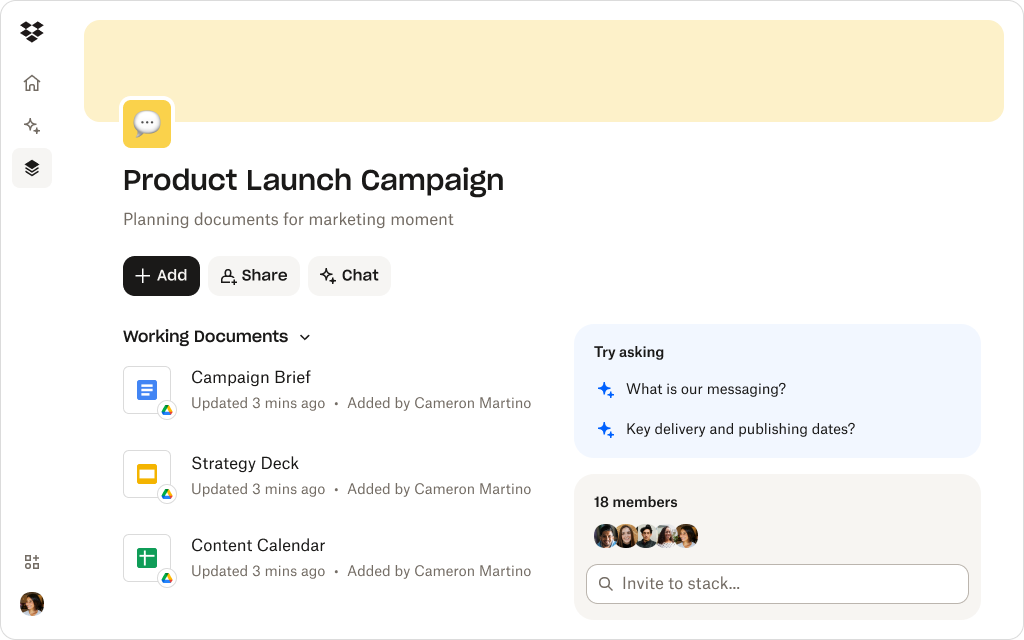
Growing your workload shouldn’t mean losing control—here’s how to scale without chaos.
For small marketing teams, growth often starts with a win—a campaign that performs better than expected, a new client onboarded, or a product launch that goes viral. But success comes with the hidden cost of more work, more files, and more moving parts to manage.
This might make scaling feel more like holding a tray of drinks on rollerskates than real progress. Deadlines pile up, folders multiply, and what once felt organized for success now borders on chaos. In the end, team members spend more time managing the work than doing the work—so the idea of scaling is moot anyway.
With connected tools and smarter organization, small teams can handle ever growing workloads without losing focus or efficiency. Scaling should feel empowering—not overwhelming. Here we’ll explore how to do it better.

Why scaling work creates new kinds of chaos
When marketing teams take on more projects, the complexity of the operation grows faster than the team’s capacity to fulfill it.
Each new campaign adds its own briefs, decks, and feedback loops, often scattering information across tools and folders. That fragmentation leads to some common scaling pitfalls:
- Duplicated work—multiple versions of the same file or asset waste valuable time
- Confused ownership—as responsibilities expand, accountability becomes unclear
- Tool overload—teams add apps to manage growth, only to create and contribute to new silos
- Slower decisions—the more moving parts, the harder it becomes to keep everyone aligned
Scaling is about maintaining clarity while doing more. The real success comes from growing efficiently—keeping projects organized, goals clear, and results consistent even as workloads expand.
The warning signs your team’s growth is slowing you down
A growing workload can feel exciting, right up until efficiency starts to slip. When that happens, scaling stops being productive and starts becoming reactive.
Watch for these early red flags:
- Project turnaround times stretch longer, even with more hours worked
- Feedback and approvals loop endlessly without closure
- Different versions of the same deliverable circulate at once
- Team members rely on side chats to stay informed
These are the symptoms of one thing more than any other—disconnection. The bigger the content load, the more critical it becomes to have a shared system of truth.
How scattered tools make scaling harder
It’s tempting to fix inefficiencies by adding more tools—another project tracker, a transformative chat app, or unique storage solution. But new platforms can often just add complexity and more context switching.
Here are a few common difficulties and the impact they have on workflows:
- Too many tabs, not enough focus—switching between platforms eats up time and sucks mental energy from committed team members
- Too many versions, not enough truth—assets drift out of sync, and no one’s sure which file is final, which makes indecision takeover
- Too many notifications, not enough clarity—important updates get buried in endless alerts and messages that become an unhelpful blur
- Too many systems, not enough strategy—energy goes into managing tools instead of moving campaigns forward
Disorganization grows fastest in environments where information lives everywhere and nowhere at once. When files are spread across multiple drives or tools, teams waste time reconciling updates instead of making progress.
Without a unified workspace, scaling amplifies confusion rather than collaboration. AI-powered features in tools like Dropbox Dash reverse that pattern—bringing everything and everyone into one connected space.
Smarter ways to grow output without more burnout
We know what happens, what it looks like, and the impact that scaling can have on teams. But what can you do?
When demands multiply and headcount doesn’t, teams feel like they’re being stretched. The solution is to work with more intelligent systems. Passion won’t get you far, you need a logical structure capable of handling growth.
Here’s how to give your team structure that expands with them and keep performance high as workloads grow:
- Standardize project setup: Create templates for briefs, deliverables, and approvals so each campaign starts from a clear framework. Consistency keeps projects moving, with no reinvention required.
- Centralize file storage: Store assets in one searchable location with consistent naming conventions. When everyone knows where to look, no one wastes time hunting for files.
- Clarify roles and checkpoints: Assign owners for each milestone to avoid duplicated work and approval delays. Accountability turns chaos into coordination.
- Automate repetitive tasks: Use AI summaries and automated updates to save time on reporting and progress tracking. If you let technology handle the boring admin, people can focus on ideas.
Sustainable growth happens when structure scales alongside creativity, giving teams the clarity and rhythm they need to keep momentum without losing focus. By focusing on clarity and connection, small teams can scale easily.
Dash makes that possible, connecting tools and surfacing context so growth never comes at the cost of burnout.
How Dropbox Dash helps teams scale content, not complexity
As teams grow, success brings challenges. Simple workflows become complex, with scattered files, repeated work, and shifting focus. The solution is a connected, AI-powered system that has the capacity to grow with you.
Dropbox Dash was built for teams that want to move faster as they grow without adding work. Here’s how it does that:
- Universal search: Dash connects across Dropbox, Google Drive, Slack, and other apps, allowing teams to find any file, brief, or deck instantly. No more “Where’s that version?” conversations slowing things down—everything you need is one search away.
- AI Dash Chat and summaries: Dash Chat condenses meetings, feedback threads, and campaign updates into quick, actionable takeaways—so scaling teams stay informed without drowning in details. This gives you the clarity you need on demand, built right into your existing workflow.
- Stacks for campaigns: Stacks give every project a shared home. Teams can group assets, notes, and feedback in one organized workspace, reducing duplication and keeping everyone aligned. Think of it as your team’s creative library, which is always current, connected, and easy to manage.
Dash helps small teams grow with confidence—managing rising content volumes and faster campaign cycles without losing visibility or control. As output scales, Dash keeps collaboration simple.

Best practices for managing more work with less friction
Growth is great, but it strains systems. More projects mean small issues like finding files become much bigger issues. Scalability means removing those obstacles to good work.
Scaling successfully involves removing friction before it slows you down. Here are a few best practices to take into account that keep this attitude front and center:
- Create shared visibility: Use dashboards or Stacks so everyone can see project status in real time. When everyone sees the same picture, no one gets left behind.
- Reduce context switching: Keep conversations and content in one connected workspace. Less tab-hopping, more time in flow.
- Document everything: As your team grows, written processes prevent confusion and maintain quality. Good documentation scales clarity instead of chaos.
- Audit your toolset: Eliminate redundant apps that complicate collaboration. Every unnecessary platform just another potential place for progress to hide.
When teams can see, find, and act from the same space, scaling feels seamless. Dash makes that possible by connecting files, feedback, and context into one workspace where teams can move faster and more easily.
See how Dash keeps scaling teams in sync
Dash Stacks help you to group campaign assets, briefs, or feedback in one organized workspace—so teams can maintain visibility and scale efficiently.
Scale your marketing workflows with Dropbox Dash
The difference between growing and scaling is sustainability and scaling shouldn’t come at the cost of control. Dash helps small teams manage more projects, assets, and approvals—all from one organized workspace.
With intelligent and secure AI-powered features, Dash keeps fast-moving teams aligned. See how Dash helps teams expand their capacity and maintain clarity—try a demo or contact sales to get started.
Frequently asked questions
By standardizing file organization, clarifying ownership, and using tools like Dropbox Dash to centralize campaign assets and communications.
Dash integrates with your existing tools and uses AI to organize, summarize, and search across content—helping small teams grow their output without extra work.
By connecting data across apps, Dash removes the need for multiple project trackers or chat tools, giving teams one clear view of all their work.
Get started with Dash
.webp)

.svg)


